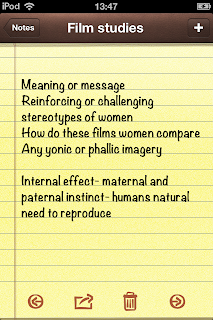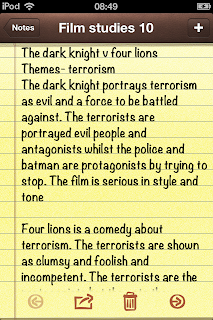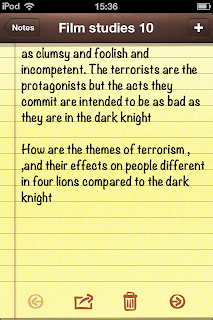How are modern day themes in The Dark Knight Rises and Four Lions used to affect modern day
audiences?
In The Dark Knight Rises, the
modern day themes are used as components to build an action film and make the
narrative relevant for modern day audiences. However, in Four Lions, these
modern day themes are used to build satire and amuse the audience despite this
contrasting with The Dark Knight Rises which uses these themes in a
serious context.
One of the
relevant modern day themes in these films is terrorism.
In this clip of The
Dark Knight Rises, we see Bane detonate multiple bombs around Gotham City.
The use of editing
is relevant and important in this clip because the use of short and quick cuts
shows the impact and scale of Bane’s terrorists. This has been done by the director,
to create a feeling of shock in his audience. There is a lot of emphasis on the
attacks by having lots of different angles and shots in the film. This shows
that the scene is important for the narrative or the rest of the film.
In this clip of Four
Lions we see a terrorist shooting a rocket launcher the wrong way, and he
falls over from the impact of the rocket leaving the launcher
The use of
Mis-en-scene here is important to the scene. The actor is dressed in
stereotypical terrorist wear and is holding a weapon. The use of costumes and
props is used by the director to represent the character and make the audience
think he is a terrorist. The use of mis-en-scene can also make the audience
connect with stock characters. For example in this clip, the audience would
associate the terrorists as Villains. But by having them do a foolish and
stupid thing, the stock character stereotype is subverted to create humour.
These two clips
both show terrorism in different ways and in different contexts. The theme of
terrorism is used in The Dark Knight Rises to make the audience
antagonize Bane whilst in Four Lions, the terrorism is used in a
slapstick style manner, by having the terrorist fail to destroy a spy plane and
instead blow up their terrorist base. The two films have different attitudes to
terrorism. In The Dark Knight, the attitude is serious. The film’s
attitude relies heavily on the theme of terrorism being a current and topical
issue in the world. The film uses a taboo subject like terrorism in order to
structure its narrative and make the audience judge its characters. Whilst, in Four
Lions, the theme of terrorism is used in a light-hearted manner, with the
use of terrorist stereotypes relevant to the audience in order for them to
laugh at it and understand that the film is making fun of these stereotypes. Four
Lions also relies on the audience’s attitude towards terrorism but instead
of using it as a narrative device, it instead uses it in order to create humour
and satire.
Another theme the
two films use is justice. Justice isn’t a topical issue like terrorism but it
is instead a theme that can be considered a personal matter for the audience,
who might have their own opinion on justice and how people deserve it. Both
films have differing opinions on justice and this is shown by how the theme is
presented within them.
In The Dark
Knight Rises, this clip shows Batman and Bane fighting as the people of
Gotham rise against the terrorists who have taken over the city.
In this clip, the
Mis-en-scene is important. The use of acting from the actors Christian Bale
(Batman) and Tom Hardy (Bane) depicts them as two powerful figures fighting.
Gradually over the course of the scene, Batman starts to overpower Bane. We can
tell all this from the acting in the sequence.
In Four Lions,
the clip below shows two policemen arguing over who they have shot, a terrorist
dressed as a bear or an innocent person dressed as a Wookie.
In this clip, the
sound is important because it shows the arguing and dialogue in the scene
between the two policemen. The message and point of the scene revolves around what
the policemen are saying. Another equally important feature of the scene is the
mis-en-scene. The use of costumes with the two policemen in riot armour and
holding guns (props) shows that a serious incident has happened but the film
subverts the audience expectations by having them shoot an innocent person.
The two films and
their portrayal theme of justice are contrasted and are complete opposites. In The Dark Knight Rises, the
theme of justice is shown as good portraying over evil, which links with The
Dark Knights, use of the classic Hollywood narrative. This scene acts as a
resolution to the disruption of the equilibrium in the narrative. However, in Four
Lions, there are almost no consequences or a sense of justice in the film.
The characters actions are left largely unpunished. This makes it more
realistic than The Dark Knight Rises and because of this; it can be
considered a black comedy. The reason these themes have been presented in these
ways is because The Dark Knight Rises status as a Hollywood film means
it is not allowed to take risks which could disappoint or not meet the viewer’s
expectations whilst Four Lions status as an independent film means it
can take risks with its story. Four Lions lack of justice in the film is
so prevalent in the film is that we can’t align with the main characters and
determine if they are heroes or villains because of the lack of consequences
and subversion of audience expectations in the film. The two different
attitudes to justice in the film affect a modern day audience because in The
Dark Knight Rises, the justice leaves the audience satisfied whilst in Four
Lions, the sense of injustice can leave the audience unsatisfied.
Another theme in
the films is redemption. Both films feature scenes of redemption or their
characters trying to redeem themselves.
In The Dark
Knight Rises, Batman is captured by Bane and put in a prison. However he
redeems himself by climbing up the wall and escaping. The screenshot here is
from the scene.
In this scene, the
use of cinematography is important. The camera is used at a low angle to
emphasise Batman’s perspective of being stuck in the prison. The low angle
makes the escape more daunting to the audience. This is to show what Batman
must overcome in order to redeem himself. This makes the audience root for
Batman. This is an example of how The Dark Knight Rises uses these
themes in order to structure a narrative.
In Four Lions,
This scene shows Omar having a change of heart about suicide bombing and he
calls his best friend Waj to try to make him change his mind too. However Waj
is already surrounded by police and blows himself up anyway.
http://viooz.co/movies/1783-four-lions-2010.html 86:43 -87-54 (There is no clip on youtube)
In this scene, the
use of editing is relevant. It shows an example of an omniscient narrative,
with the audience able to see both ends of the conversation. The humour in the
scene derives from the fast quick cuts, between the characters in their
conversation. The editing also adds pace to the scene and symbolises Omar’s
panic.
The two clips show
contrasting themes of redemption. In The Dark Knight Rises, Batman is
able to redeem himself because the character he portrays is depicted as good
whilst in Four Lions, the character of Omar, despite having a change of
heart, is unable to redeem himself when he wants to finally do something good. The
Dark Knight Rises follows the conventions of the superhero genre by having
Batman redeem himself, by being imprisoned, Batman dies metaphorically and has
to be ‘reborn’ and that is how he redeems himself. By following conventions, it
is another example of how Batman uses modern day themes to construct its
narrative. In Four Lions, the satire and comedy from the film derive
from its mimicking of terrorist stereotypes and the war on terror, however the
end, the only serious moment in the film, the director decides to ‘’punish’’
Omar even when he tries to redeem himself. This is an example of irony which
links to Four Lions being a black comedy. By having Omar’s best friend
die in a darkly ironic twist is an example of how Four Lions affects an
audience. It is presenting a message to the audience about how people ignore
the human beings behind suicide bombings.
Lastly, the final
theme present in both films is morality.
In The Dark
Knight Rises, this clip shows Bane expressing that he is ‘necessary evil’
and killing someone.
The use of
cinematography is relevant in this scene. The use of low angle from the
businessman’s perspective shows that Bane has power in the shot. This is
suggesting that when Bane talks about his own morals, he becomes powerful and
that other people become frightened of him.
In Four Lion’s
this clip shows Omar telling his son an allegory about jihad and western
culture by using The Lion King as an example. Omar is telling his son a version
of the Lion king where Simba kills his dad and lies to his friends in order for
them to defeat Scar so that Simba can become the lion king. This is an allegory
to how Omar is going to kill himself and others (Simba's dad, Musafa) so he can
express his belief that he is fighting against western culture (Scar). Simba
becoming the lion king is Omar's belief that he will go to heaven.
The use of sound is important in the
clip. Omar and his son talk in hushed tones, implying an intimate close father
and son bonding relationship. This shows that Omar is very passionate about
jihad, to the point where that he believes it is an acceptable thing to tell
his son about.
The two portrayals
of themes here are a point of comparison. Both main characters in the scenes
have examples of twisted morality which they believe strongly in. In The
Dark Knight Rises, Bane believes that taking over Gotham City will free it
of its corrupt police force and government. This alludes to the topical issue
of terrorism where jihadists have the belief that what they seek to do is
absolutely right and this theme inside the film would shock audiences. In Four
Lions, a more obvious allusion to a jihadist believing that what they
believe is right is Omar. Omar telling his son and encouraging jihadist behaviour
would shock an audience, especially with the use of a child. However because of
the Lion King allegory, the audience can laugh at the same time. This type of
shock humour is typical of Chris Morris the director of Four Lions, and is
similar to his previous television work, Brass Eye.























